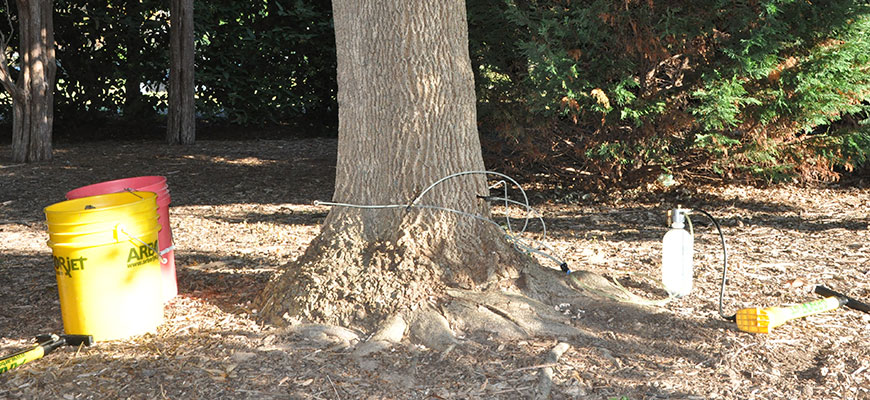Four years ago, an unwanted guest made its way to Kentucky. The invasive beetle known as the Emerald Ash Borer (EAB), native to Asia, was first discovered in Michigan in 2002 and has since spread to multiple states including Kentucky. In Louisville, it has the potential to kill most of the city’s ash trees which make up 10–17% of the trees in Jefferson County.
The EAB is a metallic green beetle, about a half an inch long and an eighth of an inch wide. The adult nibbles on leaves which causes little damage. The real trouble is the larvae which feed on the inner bark of the tree disrupting a tree’s vascular system, affecting its ability to transport water and nutrients. The EAB has already killed tens of millions of ash trees across the United States. Unfortunately, controlling insects that feed underneath tree bark is extremely challenging.
The infestation in Louisville is expected to last six or seven years. Untreated trees attacked for that length of time are unlikely to survive.
The Louisville Zoo is taking aggressive steps to save its ash trees that provide shade in many of the public areas. But even with a treatment plan in place, the Zoo has had to remove seven trees; we have decided not to treat another 19 trees for various reasons such as bad branching habits, or because they are small trees that can be replaced.
The decision to maintain only 34 of the Zoo’s 60 ash trees was not made lightly. Unfortunately, de-infestation is costly. Will Nay, our Horticulture Supervisor, estimates it will cost over $32,000 to treat the trees over the next six years. “That’s almost a financial wash when compared to taking the trees out,” Nay says.
The Zoo is using an insecticide called TREE–äge which only affects animals that feed on trees like the ash borer. It is injected into the trees with the Arborjet system and requires multiple applications. Other methods are available such as soil treatments or overhead sprays, but both of these can affect other plants nearby.
Cost is certainly a factor in deciding whether to treat the ash trees or not. But there are other considerations to take into account. Is the tree already infested, and if so, how severe is the infestation? Is there other insect damage? Are there any safety concerns like a tree that’s close to power lines or has branches that could fall and cause damage? Is it a younger tree that might by easily replaced? Larger, older trees produce oxygen and provide other benefits as well including shade and water run-off. Of course, trees with sentimental value may well be worth trying to save as well.
One thing is clear: the Emerald Ash Borer is a deadly, fast-moving threat. Although the Louisville Zoo participated in a project with the USDA in 2009-2010 to detect levels of infestation using traps, no EABs were found. Then, about a year ago, the beetles appeared actively in Louisville, especially this past spring.
Even if you haven’t seen signs of infestation yet, the time to act is now. There are arborists in the Louisville area who can treat your residential trees.
Emerland Ash Bore
What to look for:
- Sparse canopy and branches that are dead or dying. Trees with more than a 50% canopy decline are unlikely to recover.
- D-shaped holes in the bark. These holes are actually “exit” holes created when the new beetles are emerging.
- Vertical splits in the bark exposing “galleries,” tunnels beneath the bark that are S-shaped.
- Increased woodpecker activity as the birds feed on the insects.
- When the EAB has been detected within 10-15 miles of your area, your trees may be at risk. To find out whether the EAB has been detected near you, visit any of these sites for specific information:
- Kystateent.org
- Ky-caps.org
- Emeraldashborer.info
Originally published in Trunkline Magazine, Sept. 2014.

